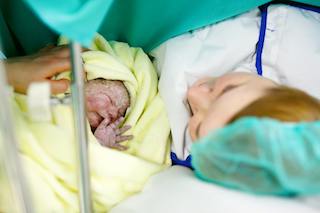 The search is ongoing into the multiple causes of prenatal and postpartum depression (PPD), the umbrella term for several maternal mental health illnesses that also include anxiety, obsessive-compulsive disorder, post traumatic stress disorder, bipolar disorder and psychosis.
The search is ongoing into the multiple causes of prenatal and postpartum depression (PPD), the umbrella term for several maternal mental health illnesses that also include anxiety, obsessive-compulsive disorder, post traumatic stress disorder, bipolar disorder and psychosis.
Now, a new Italian study adds to the ongoing research into the causes of PPD after its results show that new mothers are at an increased risk for anxiety following elective cesarean births. The finding is especially significant given the increasing rate of cesarean deliveries in industrialized countries such as the United States and Canada.
The study, titled: The role of elective and emergency cesarean delivery in maternal postpartum anhedonia, anxiety, and depression, was co-authored by Lara Giliberti, a clinical psychologist at the Policlinico Abano Terme.
“Our study was concerned with the relationship between the development of depressive symptomatology in the first postpartum and the different kinds of delivery, surgical or natural ones,” Giliberti told us. “Specifically, we wanted to investigate in the mothers, depressive, anxious and anhedonic aspects of the first days after childbirth.” (Anhedonia is a factor of depressive which involves the loss of pleasure in an activity.)
Giliberti and her colleagues used the Edinburgh Postnatal Depression Scale (EPDS) to test these factors. They considered elective cesareans to be a risk factor for postpartum depression.
“Our clinical experience has repeatedly shown us that the first days after delivery are psychologically unstable and how a good screening tool used earlier, during the hospital stay, can actually be a predictive aid for the maternal thymic course,” Giliberti told us. “In literature, studies concerning depressive symptomatology and the possible relationships with the type of childbirth are not many, and often contradicting each other, so we felt the lack of a complete answer regarding the description of the depressive symptomatology of the initial postpartum.”
Researchers also looked at the effect of emergency cesarean deliveries which had never been analyzed in a specific way in comparison to elective cesarean deliveries.
“From our psychological point of view, however, this shouldn’t been seen as completely correct,” Giliberti told us. “The path that leads a woman to give birth with a planned caesarean section is very different, in terms of expectations and imagination, compared to an emergency cesarean delivery, hence the desire to deepen the postpartum depressive spectrum, in a more specific way, in the two different types of cesarean sections.”
From the results of previous studies, Giliberti and her colleagues theorized that depressive symptomatology was significantly more present in women after a cesarean delivery, compared to a vaginal delivery. Over 2000 women participated in the study, filling out the EPDS 48 hours after delivery. Seventy-six per cent of women had a vaginal delivery and 23 per cent had either an elective or emergency cesarean delivery. Giliberti told us that the mean EPDS scores and the number of women with EPDS scores greater than 12 were comparable among the delivery groups. However, mean anxiety factor scores were significantly higher in the elective cesarean delivery group, and conversely, mean anhedonia factor scores were significantly higher in the emergency caesarean delivery group.
“We are very surprised and impressed by the importance of the results we have achieved,” Giliberti told us. “The anxious disorder detected in the sample, as well as the anhedonic one, can be a predictor of a major depressive development in the postpartum, and it would be suitable for a good perinatologist to know how the type of delivery and the differences between the caesareans affect the maternal feeling.”
Giliberti believes that it’s important to continue the research in the field of prevention and early screening, to benefit the health of new mothers and the well-being of their babies, and support for the entire family.
“Psychologically, it is known how anxiety and anhedonia could be considered two different facets competing to the depressive slope,” Giliberti told us. “In both situations, but through different paths and motivations, caesarean delivery has actually resulted in being a risk factor in the development of postpartum depression. It would be important to be able to perform a diagnostic follow-up to evaluate the actual incidence, and in what percentage, of postpartum depression.”
Patricia Tomasi is a mom, maternal mental health advocate, journalist, and speaker. She writes regularly for the Huffington Post Canada, focusing primarily on maternal mental health after suffering from severe postpartum anxiety twice. You can find her Huffington Post biography here. Patricia is also a Patient Expert Advisor for the North American-based, Maternal Mental Health Research Collective and is the founder of the online peer support group - Facebook Postpartum Depression & Anxiety Support Group - with over 1500 members worldwide. Blog: www.patriciatomasiblog.wordpress.com
Email: tomasi.patricia@gmail.com